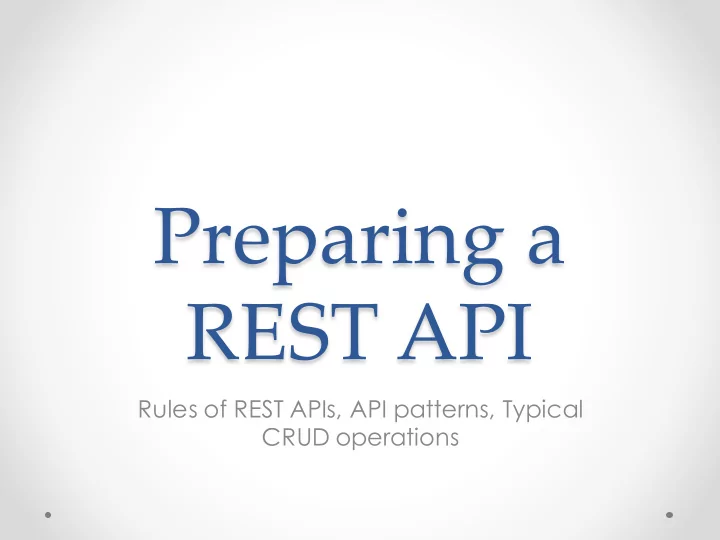

Preparing a REST API Rules of REST APIs, API patterns, Typical CRUD operations
Rules for a REST API • Recall : REST – Representational State Transfer o REST is stateless—it has no idea of any current user state or history o API – Application Programming Interface o REST API – stateless interface to your application o • Standards : REST APIs have an associated set of standards Generally best to stick to them o You’re doing things the right way if you decide to make your API public o
Request URLs • Request URLs for a REST API have a simple standard Think about your DB collections o Will typically have a set of URLs for each collection o May also have a set of URLs for each set of subdocuments o Each URL in a set will have the same basic path, and some may have o additional parameters Within a set of URLs you need to cover a number of actions, generally o based around the standard CRUD operations
Common actions • Create a new item • Read a list of several items • Read a specific item • Update a specific item • Delete a specific item
URL paths and params for an API Action URL path Parameters Example Create new contact /contacts /api/contacts Read list of contact /contacts /api/contacts Read specific contact /contacts contactid /api/contacts/123abc Update specific contact /contacts contactid /api/contacts/123abc Delete specific contact /contacts contactid /api/contacts/123abc
Request methods used in a REST API Request method Use Response GET Read data from DB Data object answering request POST Create new data in DB New data object as seen in DB PUT Update a doc in DB Updated data object as seen in DB DELETE Delete an object from DB Null
Request method links URL to desired action Action Method URL path Parameters Example Create new POST /contacts /api/contacts contact Read list of GET /contacts /api/contacts contact Read specific contact GET /contacts contactid /api/contacts/123abc Update specific contact PUT /contacts contactid /api/contacts/123abc Delete specific DELETE /contacts contactid /api/contacts/123abc contact
API URLs for subdocuments • Subdocuments are treated in a similar way, but require an additional parameter • E.g.: Action : Create a new review for a product o Method : POST o URL path : /products/productId/reviews/reviewId o Parameters : productId, reviewId o URL : /api/products/123/reviews/abd o
Responses and status code If you make a request, a good API will always respond • and not leave you hanging Every single API request should return a response • For a successful REST API, standardizing the responses is • just as important as standardizing the request format. There are two key components to a response: • The returned data o The HTTP status code o
Returning data from an API • Your API should return a consistent data format Typical formats for a REST API are XML and JSON • • Our API will return one of three things for each request: A JSON object containing data answering the request query o A JSON object containing error data o A null response o
10 Most popular status codes • A good REST API should return the correct HTTP status code Status Code Name Use case 200 OK A successful GET or PUT request 201 Created A successful POST request 204 No Content A successful DELETE request n unsuccessful GET, PUT, or POST 400 Bad Request request due to invalid content Requesting a restricted URL with invalid 401 Unauthorized credentials 403 Forbidden Making a request that isn't allowed Unsuccessful request due to invalid 404 Not Found parameter in URL Request method not allowed for given 405 Method not allowed URL Unsuccessful POST request when another object with the same data 409 Conflict already exists 500 Internal server error Problem with the server or DB server
Setting up API in express • We’ve already got a good idea about the actions we want our API to perform, and the URL paths needed to do so • We need to setup controllers and routes to cause express to do something with an incoming URL Controllers will do the actions o Routes will map incoming requests to appropriate controllers o Need to require the routes in app.js o Need to tell application when to use the routes o Define actions in the controllers o
Next steps • Either in the routes or controllers file, specify the following: The request method o The required URL parameters o The definition of the full API routes o • In controller: Return JSON and response status code from an Express request o Use Mongoose model to read data from mongoDB o Use Postman REST client to test requests to the API o
Reading data from MongoDB • Mongoose models have several methods available to them to help with querying the database. • Here are some of the key ones: find - General search based on a supplied query object o findById - Look for a specific ID o findOne - Get the first document to match the supplied query o It’s good to run query with exec() o Be sure to catch errors and return appropriate response o
Limiting return paths Limiting the data being passed around is better for • bandwidth consumption and speed Mongoose does this through a select method chained • to the model query Product .findById(req.params.productid) .select('name reviews') .exec( function(err, product) { // do error checking-product var review; review = product.reviews.id(req.params.reviewid); // do error checking for review } );
Resources http://www.restapitutorial.com/httpstatuscodes.html • Getting MEAN with Mongo, Express, Angular, and Node • Simon Holmes November 2015 ISBN 9781617292033 440 pages printed in black & white
Recommend
More recommend